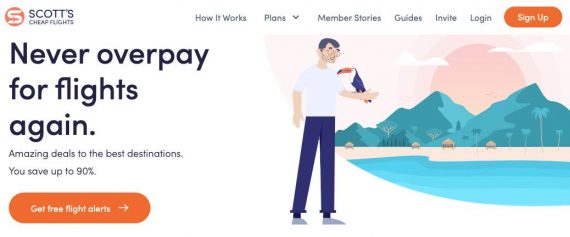Paid newsletters are popular in the creator economy. But no matter how good the content, creators still need to promote their work to attract subscribers.
Creators are podcasters, YouTube personalities, bloggers, musicians, business coaches, and the like. When compensated directly, they form the creator economy.
Newsletter promotion can take multiple forms, including advertising, email, pitches in free content, landing pages, and word of mouth.
1. Advertising
As with any other form of ecommerce, paid newsletter subscriptions often require advertising.
Consider the example of “Scott’s Cheap Flights,” a popular paid newsletter with annual pricing tiers ranging from $50 to $200.
—
Search for “discount flights” on Google you’ll likely see an ad for Scott’s paid newsletter.

The Scott’s Cheap Flight paid newsletter advertises for industry-appropriate keywords and audiences.
As with any ad program, test keywords and audiences to find the most successful campaigns while keeping an eye on the ratio between customer lifetime value and customer acquisition cost.
Advertising can also work with other tactics on this list. For example, some paid newsletters are the premium version of a free subscription. For those publishers, lead ads on Facebook or Google can drive free subscription signups. Then the free newsletter can promote the paid version.
2. Email
It may seem odd to suggest that email could promote a paid newsletter, but email marketing is among the best ways of getting paying subscribers.
Beyond upselling free subscribers, a creator could offer a free preview and then use email marketing to encourage the upgrade.
The Browser, which curates articles and has around 75,000 subscribers, lets folks try a free preview. Then it uses that preview and associated landing pages to encourage upgrades to a paid subscription.
Lastly, email marketing can sell gift subscriptions. A mom who loves her paid newsletter about saving money might buy a subscription for her college-age son. A grandmother who loves cooking might get a gift subscription for a grandchild to easily share recipes.
3. Pitches in Free Content
The Browser’s preview is similar to pitching the newsletter in various forms of free content. For example, many YouTube channels have associated paid products, including newsletters.
It is common for these YouTube creators to promote their newsletter in every new video.
Podcasters take this same approach. Bloggers too. Even folks who tweet.
Benedict Evans, a London-based analyst, publishes a tech newsletter with about 170,000 subscribers. The newsletter sells for $10 per month or $100 annually.
Evans, who has more than 340,000 followers on Twitter, has promoted this newsletter there since at least 2019. It’s an example of a pitch in free content.
4. Landing Pages
A paid newsletter’s landing page should be a search-engine-friendly sales funnel that drives conversions. The landing page content could be a mix of articles, videos, or anything else to drive subscriptions.
The page should have a clear value proposition for the potential reader, and it should also be tested. Don’t just build it and forget it.
The “What to Cook When You Don’t Feel Like Cooking” newsletter began as a cookbook concept but is now a popular paid subscription. Its signup page on Substack is simple but (apparently) effective.

The “What to Cook When You Don’t Feel Like Cooking” newsletter began as a cookbook concept but is now a popular paid subscription.
5. Word of Mouth
A well-written, high-value paid newsletter will almost certainly generate word-of-mouth subscriptions. And with a bit of encouragement, it might generate a lot of them.
- Include a share link in each newsletter.
- Develop a referral (affiliate) program.
- Offer discounts.
- Ask loyal readers to recommend.
People like to share when they find something interesting, helpful, or entertaining.








